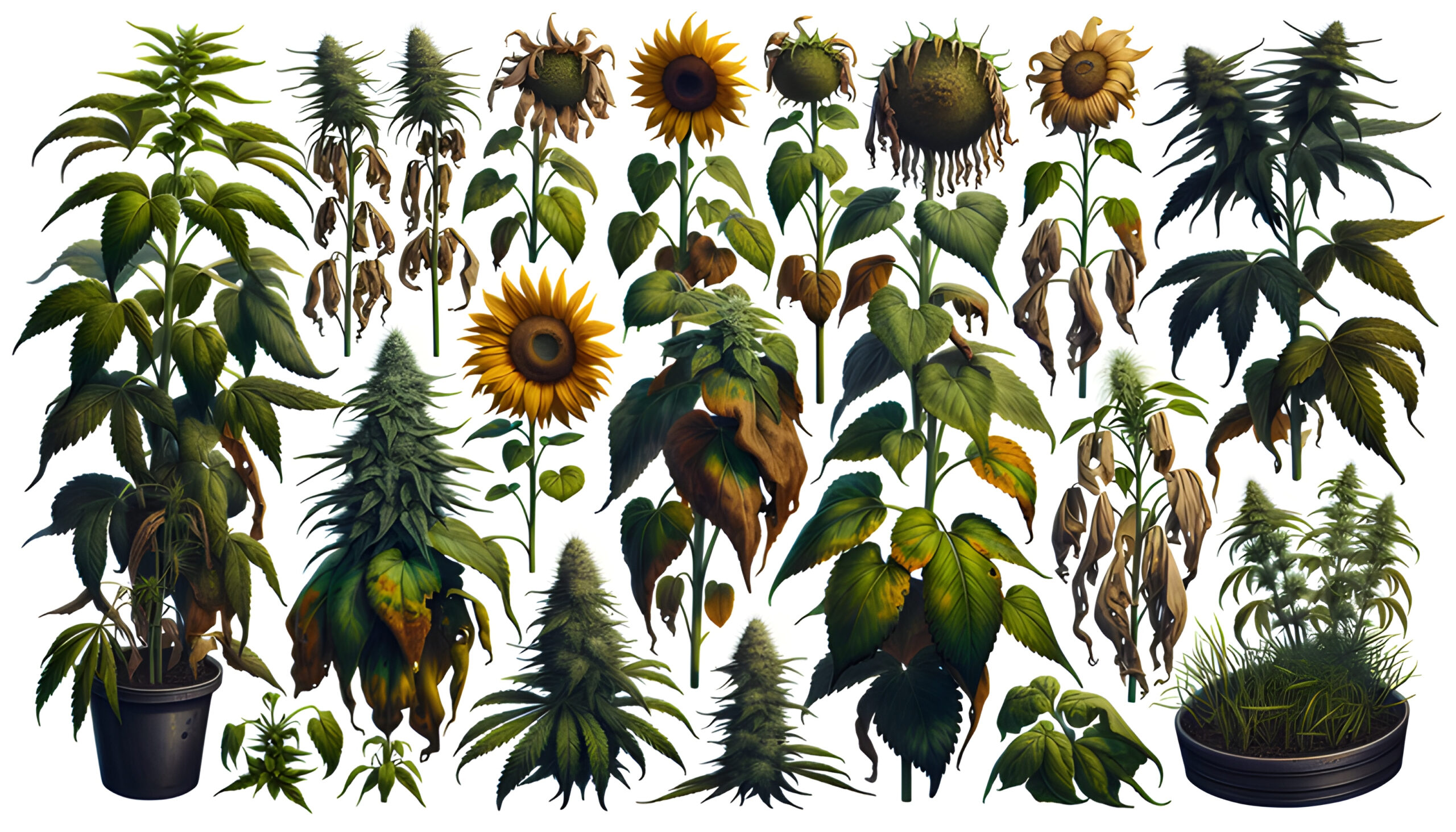Introduction: Unveiling the Importance of Recognizing Signs of Nutrient Deficiency in Plants
The vibrant life of a plant hinges upon the availability of essential nutrients. Just as humans need a balanced diet to thrive, so too do plants. Neglecting this basic need can lead to stunted growth, reduced productivity, and in severe cases, plant death. But how can we tell if a plant is undernourished and in need of help? The answer lies in recognizing the signs of nutrient deficiency in plants. As gardeners, farmers, or botany enthusiasts, understanding these signs is crucial to ensure the health and vitality of our green companions. This introductory section aims to underscore the importance of this topic and prepare the ground for in-depth exploration of specific nutrient deficiencies, their symptoms, solutions, and preventative measures in the following sections.
Understanding Plant Nutrient Deficiency: A Broad Overview
Plant nutrient deficiency, a critical issue often overlooked, can severely hamper the growth and development of plants. It’s a complex condition that occurs when plants are unable to absorb the necessary nutrients from the soil. This can result from various factors including poor soil quality, improper watering, or the absence of certain essential nutrients. Recognizing the signs of nutrient deficiency in plants is pivotal to rectify the situation promptly. Symptoms can range from yellowing leaves, stunted growth, to poor fruit production. Understanding these signs can offer valuable insights into the plant’s overall health and help determine the appropriate steps to replenish the deficient nutrients, thus ensuring optimal plant growth.
Key Takeaways:
- Plant nutrient deficiency hinders plant growth and development.
- This condition occurs when plants can’t absorb necessary nutrients from the soil.
- Deficiency can be due to poor soil quality, improper watering, or lack of essential nutrients.
- Recognizing signs of nutrient deficiency in plants is crucial for timely intervention.
- Symptoms can include yellowing leaves, stunted growth, or poor fruit production.
- Understanding these signs can inform about the plant’s overall health.
- Identifying the deficiency helps determine steps to replenish the deficient nutrients.
- Addressing nutrient deficiency ensures optimal plant growth.
Identifying the Ten Most Common Signs of Nutrient Deficiency in Plants
Every plant lover should be adept at noticing the signs of nutrient deficiency in plants. It’s not just about a plant’s growth stunting, but also about their color, leaf shape, and overall health. The top ten common signs include yellowing leaves, stunted growth, leaf curling, spots on leaves, wilting, poor flowering, leaf dropping, poor fruit production, weak stems, and slow growth. Each sign is a silent cry for help, signaling that the plant is lacking in essential nutrients. As stewards of green life, it is our responsibility to observe, understand, and respond effectively to these signs for the betterment of our plants.
Exploring Detailed Symptoms of Specific Nutrient Deficiency in Plants
Each plant nutrient deficiency reflects distinct signs that can help diagnose the problem. These signs of nutrient deficiency in plants are often visible and can serve as a guide to understanding the plant’s needs. For instance, nitrogen deficiency often results in yellowing of leaves, while a lack of phosphorous could cause dark, bluish-green foliage. Potassium deficiency, on the other hand, could lead to browning or curling leaf tips. Calcium deficiencies might result in distorted new growth or black spots on leaves. By observing these signs, one can identify and rectify nutrient deficiencies to ensure healthy plant growth.
The Role of Soil Testing in Diagnosing Nutrient Deficiency in Plants
Soil testing plays a pivotal role in pinpointing the signs of nutrient deficiency in plants. This vital process, often overlooked, can save your garden from imminent doom. It’s not just about the presence of nutrients, but their accessibility to plants’ roots. By examining the soil’s pH level, organic matter content, and nutrient profile, it offers valuable insights into what may be lacking. It’s like a comprehensive health check-up for your garden, revealing not just deficiencies but excesses too, which can be equally damaging. Thus, soil testing emerges as a crucial tool in plant healthcare, serving as a guidepost for effective nutrient management.
Effective Solutions for Nutrient Deficiency in Plants: A Comprehensive Guide
Now that we’ve identified the signs of nutrient deficiency in plants, it’s time to delve into solutions. The first step is to rectify the imbalance in the soil. An easy way to do this is by adding organic matter like compost or manure, which helps improve soil fertility and structure. Using specific fertilizers can also be beneficial. For instance, adding a nitrogen-rich fertilizer can resolve a nitrogen deficiency. Secondly, proper watering practices are crucial. Over or under watering can lead to nutrient deficiencies as water is necessary for nutrient uptake. Lastly, it may be beneficial to adjust the pH of your soil. Certain nutrients are more available at different pH levels, so adjusting it can help plants access the nutrients they need. Remember, recognizing the signs of nutrient deficiency in plants is just the beginning – taking action is where the real difference is made.
The Value of Preventative Measures: Avoiding Nutrient Deficiency in Plants
Prevention, they say, is better than cure. This is as true for plants as it is for humans. By proactively taking steps to provide plants with the necessary nutrients, you can avoid the signs of nutrient deficiency in plants, thereby ensuring their health and vitality. This can be achieved through the application of balanced fertilizers, rich in all the essential micro and macro nutrients. Furthermore, regular soil testing can help determine the nutrient content of your soil, ensuring your plants are not deprived of their dietary needs. Composting is another effective preventative measure, as it helps replenish the soil with organic matter and beneficial microbes. Effective water management also plays a crucial role in nutrient absorption. Ensuring the optimum moisture content in the soil can significantly enhance nutrient uptake and prevent deficiency. So, embrace these preventative measures and let your plants thrive in robust health and beauty.
Unmasking the Hidden Signs of Nutrient Deficiency in Plants: Your Ultimate FAQ Guide
The world of plants is a fascinating adventure that is often marked by glorious blooming seasons and sometimes, less than perfect moments. Among the challenges that plant enthusiasts often face is nutrient deficiency in plants, a condition that may manifest in a myriad of confusing symptoms. This guide seeks to demystify this challenge by providing answers to frequently asked questions.
What are the common signs of nutrient deficiency in plants?
Common signs include yellowing or browning leaves, slowed growth, small and misshapen leaves, or even a total halt in growth. However, it’s key to mention that these symptoms can also indicate other plant issues, not just nutrient deficiency.
Why is my plant’s leaf turning yellow?
When your plant’s leaves turn yellow, it might be signaling a deficiency in certain nutrients such as nitrogen, iron, manganese, or zinc. However, this could also be a sign of overwatering or poor drainage.
How does nutrient deficiency affect the growth of my plant?
Nutrient deficiency can severely stunt the growth of your plant. Depending on the nutrient missing, it may lead to weak stem structure, reduced flowering, or even death of the plant.
Can a nutrient deficiency lead to a plant losing its leaves?
Absolutely. In severe cases of nutrient deficiency, a plant can begin to shed its leaves as a survival mechanism. This is the plant’s way of conserving resources.
Are there specific nutrients that are commonly deficient in plants?
Yes, nitrogen, phosphorus, and potassium are the most commonly deficient nutrients. These are essential for the plant’s growth, bloom, and overall health.
How can I correct a nutrient deficiency in my plant?
Correcting a nutrient deficiency starts with identifying the missing nutrient. Once you’ve done this, you can replenish the missing nutrient using a high-quality fertilizer or compost.
Is it possible to prevent nutrient deficiency in plants?
Yes, with regular soil testing and proper fertilization, you can prevent nutrient deficiency in your plants. Providing your plants with a well-balanced soil environment is key to their overall health and growth.




